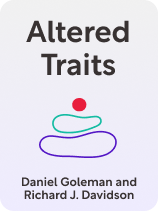

This article is an excerpt from the Shortform book guide to "Altered Traits" by Daniel Goleman and Richard J. Davidson. Shortform has the world's best summaries and analyses of books you should be reading.
Like this article? Sign up for a free trial here.
Is meditation just a passing fad, or can it truly change your brain? What benefits can you expect from a regular meditation practice?
Meditation has gained popularity in recent years, but its effects are often misunderstood. Altered Traits, a book by Daniel Goleman and Richard Davidson, explores the science behind meditation. The authors separate fact from fiction and reveal how different types of meditation can impact your mind and body.
Read on to discover the surprising ways meditation can transform your life, backed by rigorous scientific research.
Altered Traits Book Overview
Altered Traits, a book by Daniel Goleman and Richard Davidson, discusses the progress of the West’s scientific study of meditation. With a focus on identifying rigorous studies, the authors separate the signal from the noise to clarify what we do and don’t know about how meditation can change the mind—and, therefore, the meditator.
As they put it, meditative practices have long proven difficult to understand and explain. For instance, hucksters and modern businesses seeking to capitalize on the popularity of meditation often overhype its benefits. This difficulty in understanding meditation spills over into research, where it muddies the waters of understanding and casts doubt on the results of academic studies.
To address this dilemma, the authors define meditation and clarify why studying it is hard. They then detail the most clearly supported benefits of meditation and argue that the practice has one key effect: It alters traits. In other words, it produces lasting changes to your brain and therefore how you live.
Goleman (Focus, Emotional Intelligence) and Davidson (The Emotional Life of Your Brain) are both psychologists, writers, and lifelong meditators who helped pioneer research on meditation in the modern West. Our overview presents their ideas in three parts:
- First, we’ll cover what meditation is.
- Second, we’ll explain why rigorous research on meditation is both difficult to conduct and crucial to do properly.
- Third, we’ll discuss what the best studies (so far) say about meditation and how it can change you.
Meditation: Definitions, Origins, and Contemporary Manifestations
To start with, we’ll cover how the authors define meditation, explain its traditional origins, and discuss what meditation has become in the modern West.
Meditation Is a Field of Practice
To begin, the authors make one key clarification: Meditation isn’t a single thing, but rather a field of practice. That is, “meditation” is similar to “athletics,” in that it refers to a wide variety of techniques and approaches. Different forms of athletics train your body in different ways, just as different forms of meditation train your mind in distinct ways.
As the authors explain, this means that the specific kind of meditation you choose corresponds to the results you get. So, if you want to research or practice meditation, you need to get precise about what kind you’re interested in. Pick a specific kind with means and ends that appeal to you. That way, it’ll be much easier to stick with your research or practice because you’ll enjoy the effort and the payoffs.
For instance, you wouldn’t practice barre to get a bodybuilder’s physique. In the same way, you wouldn’t prioritize loving-kindness meditation (which centers on cultivating compassion) if you want to train your ability to concentrate at will.
The Buddhism That Came to the West
If meditation refers to a field of practice rather than a singular thing, then what specific methods came to the West?
To answer this question, the authors explain that their interest in meditation began when they traveled to India to explore the spiritual traditions of the far-flung subcontinent. Distilling their experiences, they say that the most prevalent form of meditation in the modern West—mindfulness—comes in large part from Theravada, the oldest of the three major Buddhist schools. Mindfulness is a practice that centers on developing a calm, nonjudgmental awareness.
Theravadan teaching draws largely on the Visuddhimagga, a fifth-century Pali text that describes the Theravadan understanding of the Buddha’s teachings. According to the authors, when Buddhist organizations revitalized and popularized the Theravadan tradition in Burma during the 20th century, they stripped down its elaborate theory and practice to present a simplified version of meditation to the public.
That meditation method, the authors say, became what we know today as mindfulness. When they and a number of other Westerners went to India in the 1970s, they were taught according to the Burmese Theravadan tradition. They brought that method back with them.
Traditional Paths to Enlightenment
So modern mindfulness reached the West through the Burmese Theravadan tradition that the authors studied in India. But, what is it in practice, and how does it fit into the tapestry of traditional Buddhist practices? Historically, modern mindfulness draws on insight meditation, which the Buddha innovated to improve an earlier focus-based meditation method. Let’s explore that focus meditation first.
Focus Meditation
According to the authors, early Indian meditation practice centered on jhana, a state of intense bliss that arises from focusing on a single object like a candle or your breath. By repeatedly drawing your attention back to that focal point, you develop a quiet, absorbed state of concentration that, over time, becomes undisturbed by ordinary mental chatter.
The Visudhimmagga describes eight stages of jhana, beginning with absorption in one-pointed focus. Ultimately, the practice of jhana culminates in a final state of complete absorption in focus and accompanying sensations of blissful tranquility.
Insight Meditation
The Buddha is said to have practiced focus meditation. However, he also realized that one-pointed focus needs the complement of insight.
With a strong basis in focus meditation, which trains you to access deep concentration at will, you can also remain mindful—or open, nonreactive, and nonjudgmental—to whatever arises in your mind. In other words, you first focus, and then you learn to relax into a state of calm, open awareness by quietly observing the cacophony of transient thoughts, feelings, and sensations that you experience.
This way of being aware is called sati, which we translate as mindfulness. In the modern West, practitioners often apply sati through vipassana, the simplified mindfulness meditation method devised by Burmese Theravadans and taught to the authors (and other Westerners) in the 1970s. Most often, you start a vipassana practice by developing mindful awareness of your breath. In time, you gradually expand that basic awareness to observe and become mindful of the rest of your subjective experience.
According to the authors, when the Buddha combined focus with insight, he innovated a new path to nirvana, or enlightenment: a state of complete spiritual liberation characterized by tranquility, clarity of mind, bliss, and unshakably mindful awareness. For the authors, the question remained: Is enlightenment real? Do lifelong meditators and yogis really experience these states of profound concentration, bliss, clarity, and liberation?
Mindfulness in the Modern West
In its transition to the modern age and the Western world, mindfulness meditation has been reinterpreted and reformulated for many fields and uses. The authors explain that today, Westerners approach meditation either through more traditional means or more secular means:
- Via traditional means, you practice meditation as a way of life. You follow a time-honored path toward enlightenment, learning from a lineage of established teachers. Monks who take Buddhist vows and live in monasteries exemplify this path.
- Via secular means, you take meditation more as a tool for worldly self-improvement outcomes, such as better mental and emotional health. For instance, an entrepreneur might practice mindfulness to focus and to regulate his stress.
Along these two paths, the authors describe five depths of meditative practice that gradually step out from the deep end of traditional practice and into the shallow but broad end of secular practice:
- The first depth is “pure” meditation, or meditative practice done in a traditional context such as a monastery. This is the deepest possible commitment to practice.
- The second depth is meditation pursued with a similar level of seriousness, yet practiced in a Western context for a Western audience.
- The third depth is meditation practiced seriously, but more for personal growth than spiritual liberation. Rather, the goal is practical gains—for instance, some people meditate to improve their cognition and therefore become more productive.
- The fourth depth is meditation taken less seriously, used more as a “life hack” than a regular practice. For example, many people use apps or guided meditation videos to get a dose of mindfulness in a more ad hoc way and for purposes like stress relief.
- The fifth depth is speculative—the authors suggest that meditation technologies may become more democratically accessible, such that anyone can freely get meditation guidance on their phone at any time.
According to the authors, practicing meditation through traditional means, with a deep level of commitment, gives the most profound results. This would correspond to the first and second depths above. In the authors’ view, these more authentic ways to meditate provide the most compelling benefits, such as lasting changes to your brain that increase your capacity for compassion, selflessness, and tranquility.
In contrast, secular means (the third, fourth, and fifth depths) offer accessible benefits to more people. After all, not everyone is able to commit to a monastic lifestyle in a traditional Buddhist setting. However, secular tools often overpromise their benefits. For example, an app won’t solve all your mental health challenges (as some marketing might imply)—but it might, as the authors say, provide some shallower positive gains.
How Meditation Became a Field of Study
Now that we’ve shared how the authors define meditation, we’ll explain why it’s been so challenging to study. As they say, meditation research is a young and rapidly growing field, and much of the difficulty in understanding meditation arises from confusion about what it is, how to distinguish the forms it takes, and how to properly measure its effects.
We’ll detail the broad basis for meditation research (neuroplasticity, or the brain’s innate ability to adapt to stimulation). We’ll also describe the common misunderstandings and mistakes made in meditation research. Last, we’ll explain why it’s crucial to remain vigilant against hype when evaluating research and claims about meditation.
Meditation Induces Neuroplasticity to Change the Brain
When the authors first pushed to study meditation, the conventional academic perspective was against them. Most serious research scientists thought that meditation was too subjective or woo-woo, and that the mind was a black box—impossible to study rigorously.
Despite this resistance, the authors hypothesized early on that meditation could produce the titular “altered traits”—lasting changes to people’s basic characteristics. Depending on how you meditate, these can include increased stress resilience, emotional intelligence, and cognitive capacities such as attention, focus, and more.
Early on, the techniques available to measure the effects of meditation weren’t effective enough. However, the discovery of neuroplasticity provided a broad, scientifically viable basis for their research.
Neuroplasticity is the brain’s ability to change in response to some activity or stimulus. For instance, research on rats found that their brain health worsened after they were merely placed closer to unhealthy rats. When it comes to meditation, the discovery of neuroplasticity made it reasonable to claim that meditation could alter the brain. And as it turns out, the authors explain, the mental training of meditation does physically modify the structure, size, and functioning of brain tissue. As a result, traits that relate to those brain changes can shift as well.
Mistakes and Misconceptions in Research
Despite this evidence of the positive effects of meditation, it remains difficult to study. Research on meditation varies in quality, and mistakes and misconceptions can stand in the way of rigorous work.
Mistaking the Peaks for the Path
According to the authors, many researchers mistake the highs that meditation produces—states of deeply absorbed awareness, for instance—for the whole thing. However, they say, these highs are just temporary states that are more akin to an exercise high than a lasting gain in meditative capability.
For another analogy, consider weightlifting. When you work out, you get a pump—a temporary increase in the size of your muscles. But these pumps aren’t your gains—the lasting increases in the size and function of your muscles. In meditation, the high states are the pumps and the gains are the altered traits. When research focuses on temporary peaks as outcomes, it misses the broader picture of meditation as a long-term process with long-term aims.

———End of Preview———
Like what you just read? Read the rest of the world's best book summary and analysis of Daniel Goleman and Richard J. Davidson's "Altered Traits" at Shortform.
Here's what you'll find in our full Altered Traits summary:
- How the West has distorted true meditation
- Why meditation is so difficult to study
- The 5 proven benefits of having a meditation practice






